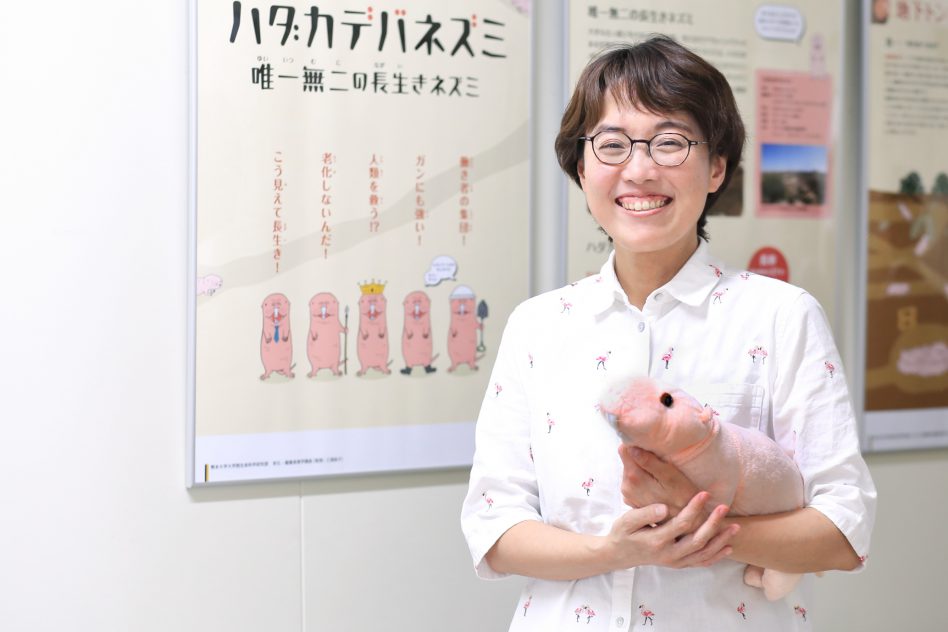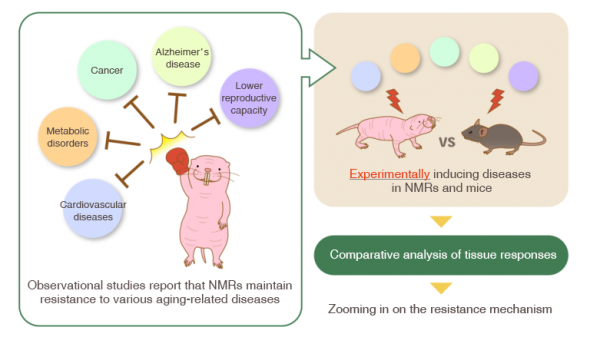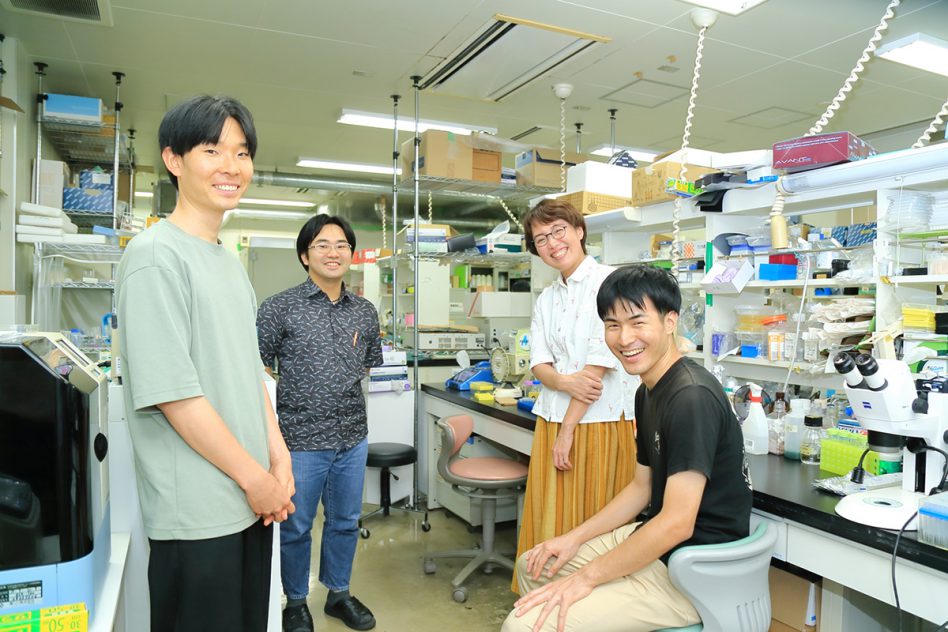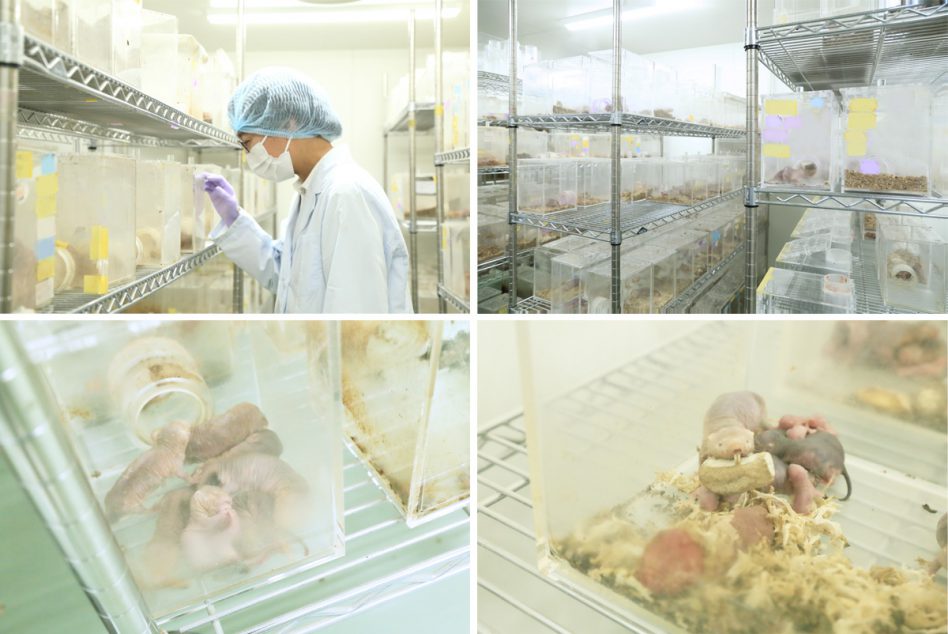3S is the abbreviation for “Seiwa Scholars Society,” which consists of the past and current Inamori Research Grant recipients. The 3S has evolved since 1997 with the hope that the interactions among the various specialties of the 3S members can lead to the further development of the research of their own. In the series “Visiting 3S Researchers,” we interview researchers in 3S who are very active in a variety of fields. The 15th interview is with Dr. Kyoko Miura (2020 Inamori Research Grants Recipient) from Kumamoto University.
In the African Savanna, there live rather curious mammals known as naked mole-rats. Building nests underground, they lead a eusocial lifestyle similar to that of ants. It is not just their appearance or unusual mode of living that sets naked mole-rats apart. They are less prone to cancer and live about ten times longer than mice. Unlocking the secrets of their unique constitution could have significant applications in human medical care. Dr. Kyoko Miura is the researcher of naked mole-rats in Japan. We visited Dr. Miura’s laboratory at Kumamoto University to discuss her journey and her fascinating research.
Why I Started Researching Naked Rats with Protruding Teeth
──How did you first encounter naked mole-rats?
Dr. Miura (title omitted below) I knew about naked mole-rats (NMRs) probably from picture books, but I didn’t consider them as a research topic until my graduate school years. I studied under Dr. Shinya Yamanaka of Kyoto University and Dr. Hideyuki Okano of Keio University, focusing on the safety of induced pluripotent stem cells (iPSCs) and their therapeutic applications. However, I wasn’t sure what path I wanted to pursue after completing my doctoral program. During my graduate research, the techniques for generating mouse and human iPSCs were established, opening up a wide range of possibilities in this research field. At the same time, another groundbreaking technology—next-generation sequencing—was coming into practical use and gaining traction. This technology enabled rapid sequencing of large amounts of DNA base pairs, making it possible to study animals with previously unknown genomic features, thereby introducing new subjects for research.
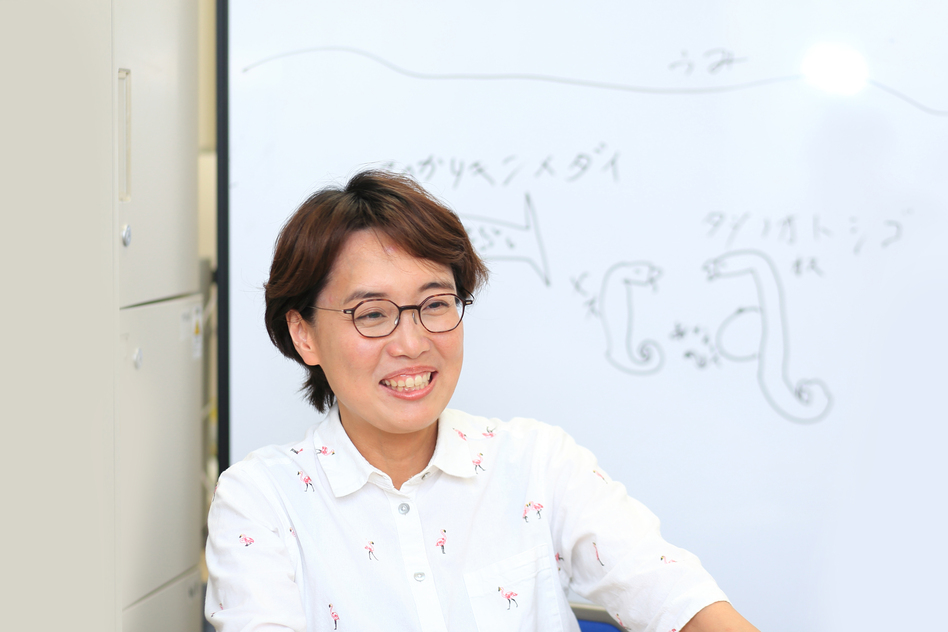
That shifted my focus to studying unusual creatures with unknown and unique characteristics that humans lack, using the combination of traditional techniques and new technologies such as next-generation sequencing. I wasn’t merely seeking a “strange” research subject; I also hoped my research outcomes could contribute to the treatment and prevention of human diseases some day. During my doctoral studies, I evaluated several potential animals before ultimately deciding to study NMRs.
──How did you manage to study NMRs that are native to Africa?
Miura Fortunately, I didn’t have to travel all the way to Africa. Dr. Kazuo Okanoya, a researcher studying animal behavior at the Institute of Physical and Chemical Research (RIKEN) at the time, was the only person in Japan working on the research of vocal communication of NMRs (Dr. Okanoya is now a Professor at Teikyo University and an Emeritus Professor at The University of Tokyo). In 2009, during the fourth year of my doctoral program, I contacted him to express my interest in conducting molecular biological research on NMRs. So off I went to meet him.
I was optimistic at that time, hoping he might include me in his team so we could advance our research together. To my great surprise, the first thing he said when we met was, “Miura-san, I have bad news for you.” He told me that he was withdrawing from his NMR research and that I could have all thirty NMRs he had.
I never imagined such a situation, and I panicked. I was just a graduate student then, with no lab to call my own. I had no idea how I could possibly breed thirty NMRs! However, I convinced myself that this was a once-in-a-lifetime opportunity I couldn’t let slip away. Without any practical plan whatsoever, I replied, “Thank you, Sir. I will take care of them.”
As soon as I left Dr. Okanoya’s office, I went to see Dr. Okano, who was then with the Keio University School of Medicine and whom I had the honor of collaborating with in research (Dr. Okano is now affiliated with the Keio University Regenerative Medicine Research Center). When I told him what had happened, Dr. Okano showed an interest in my story and gave me the green light to breed NMRs in his lab. Having taken over Dr. Okanoya’s NMR research without a hitch, I frequently stayed at his lab for a year to learn how to breed NMRs before transferring them to Dr. Okano’s lab at Keio University. After studying in Dr. Okano’s lab, I established my own lab at Hokkaido University and then moved to Kumamoto University. Meanwhile, the scale of breeding expanded, leading to what it is today.
Controlling Cell Death/Senescence to Reduce Inflammation, Which Helps Prevent Aging and Cancer
──What research plan did you design involving NMRs?
Miura NMRs have remarkable traits: they live long and exhibit delayed aging, making them less prone to age-related decline of physiological functions. They are also cancer-resistant, with long-term research on their causes of death showing that they rarely develop cancer. Additionally, NMRs possess other intriguing properties, such as resistance to various aging-related diseases and their unique eusocial system. Only the queen and a few breeding males are responsible for reproduction, while other colony members work as workers.
Unsure where to start, I decided to begin by studying the molecular mechanism of NMRs’ cancer resistance. I planned to take advantage of my research background from graduate school, where I elucidated tumor formation mechanisms in mouse and human iPSCs.
The above diagrams are from the website of the Kumamoto University Naked Mole-Rat Lab , led by Dr. Miura. With videos and illustrations, the website offers an introductory explanation of the concept and highlights of their research.
Miura Since we didn’t have enough NMRs to start analyzing their tumor resistance, we had to wait for them to reproduce. However, possibly because of the stress of moving from RIKEN to Keio University, the queens stopped breeding. Knowing that they might resume breeding if we isolated workers from the queen and paired male and female NMRs, we formed various pairs and tried different isolation methods, day-by-day eagerly awaiting the birth of a new queen. For 18 months, whenever Dr. Okano asked if a new NMR had been born as we passed each other in the corridor, I repeatedly told him, “Not yet.” You can imagine how relieved I was to finally find a pregnant NMR! I must say it was really agonizing, spending days wondering what I would do if no newborn ever arrived after waiting two years. I even had a lighthearted plan to escape to a southern island or somewhere, leaving a note in Dr. Okano’s office saying, “Apologies for not having any pups,” hoping it would make people laugh at a drinking party someday. Fortunately, I didn’t have to carry out this plan, as we eventually welcomed a new addition.
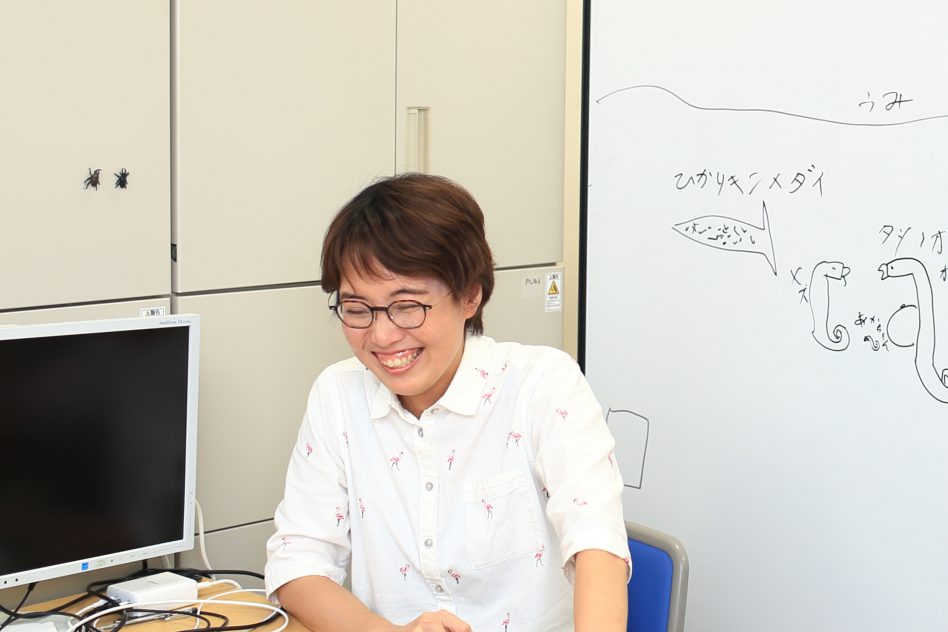
──You generated NMR iPSCs while struggling to increase their population, right?
Miura Correct. I tried to establish a technology for generating NMR iPSCs, hoping to conduct experiments that could continue even if the population didn’t increase. Initially, I was concerned about whether it would be possible to generate NMR iPSCs. The iPSC generation process shares some similarities with the process of cells becoming cancerous, which led me to suspect that cancer-resistant NMR cells might not reprogram into iPSCs. By shedding light on the process, I was expecting to uncover a cancer-resistant mechanism unique to NMRs. However, when I began the work, I was surprised by how easily I was able to generate iPSCs. I felt a bit disappointed that my initial forecast turned out wrong. Still, I thought that was fine, as iPSCs are valuable tools for various types of research, so I began looking into their properties in greater detail.
Dr. Shingo Miyawaki, then a graduate student, and other researchers joined me in the analysis, leading to an interesting discovery: Unlike mice or human iPSCs, undifferentiated NMR iPSCs don’t form tumors when transplanted. A closer look into the mechanism led us to realize that two cancer-related genes function differently in NMRs. We wrote a paper on this finding, which was duly published.*1
──What other research topics have you worked on?
Miura With the NMR population now increased, we began examining cancer resistance in their tissues. My team included Dr. Shusuke Fujioka, then a graduate student, and Dr. Kaori Oka, who was a postdoctoral fellow at the time (now an Assistant Professor at Kumamoto University). We administered carcinogens to NMRs to find that none of them developed cancer as far as we could determine. Further analysis revealed genetic mutations in the NMR genome that result in the loss of the ability to induce necroptosis, a type of cell death associated with induction of tissue inflammatory responses related to tumor development.*2 Based on various analyses, we concluded that the loss of necroptosis-inducing ability in NMRs might act as a mechanism to suppress carcinogenesis in vivo.
We also explored the mechanism behind NMRs’ delayed aging. In mice and humans, some of the aging or damaged cells stop division and become senescent cells. These cells accumulate in the body with age and release substances that trigger inflammation in nearby cells, a known cause of physical aging and age-related diseases. Dr. Yoshimi Kawamura, then a postdoctoral fellow (now an Assistant Professor at Kumamoto University), and I discovered that senescent cells in NMRs trigger cell death. Through detailed analysis of NMRs’ senescent cells, we discovered that apoptosis is induced by activating serotonin metabolism in these cells, which produces hydrogen peroxide.*3 This removal of senescent cells through cell death is supposed to contribute to NMRs’ delayed aging and cancer resistance.
Now that our NMR population has grown to approximately 1,600 individuals and we have more researchers in the lab, we have the freedom to pursue a diverse range of research projects. While focusing on elucidating NMRs’ disease-resistant mechanisms, we are also looking into their social structure and working on developing genetic modification technology for NMRs.
Tackling “Scientifically Exciting” Research Without Chasing Two Hares
──When did you decide to pursue a career as a researcher?
Miura I didn’t consider becoming a professional researcher until I joined a lab in my senior year of college. As an undergraduate student, I was so deeply involved in band activities that I was almost tempted to pursue a musical career. However, as I continued conducting experiments, my interest in research grew steadily. After I knew it, I began to think I was meant to be a researcher.
I was a student in the Department of Chemistry, Faculty of Science, but I took an interest in molecular biology, particularly embryonic stem cells (ESCs), which can differentiate into any type of embryonic cell that forms the body. They are, so to speak, the very source of life. That curiosity brought me to the lab of Dr. Yamanaka, who was then studying ESCs at the Nara Institute of Science and Technology. For my doctoral program, I moved to Kyoto University, where Dr. Yamanaka had taken up a new position. Switching to such a different research field was challenging at times, but I was able to grow thanks to the support of so many people.
──Afterwards, you shifted your research focus from iPSCs to NMRs. If I may ask, how did Dr. Yamanaka react to your decision?
Miura He was definitely surprised. I think he might have been a bit disappointed internally, but he fully supported the path I chose. He was also kind enough to give me advice, saying, “If you’re going to do it, don’t do a half-hearted job but go all the way. Rather than studying NMRs alongside iPSCs, once you’ve made up your mind, just focus on NMRs and push forward with everything you’ve got!” I couldn’t agree more, and I really appreciated his words. Had I continued my iPSC research, it might have become the centerpiece of my work. In that case, I may not have been able to carve out a unique path in NMR research.
── Your lab covers a broad range of research topics. How do you select what to work on?
Miura When members of my lab choose their research topics, I sit down with them to discuss and help them select one aligned with their interests. We take the time to evaluate whether the proposed topics are truly “scientifically exciting.” Every research theme has its own element of interest, though its degree and nature vary. Some are interesting because they shed light on fundamental phenomena of life, while others are exciting due to their potential to uncover previously unanticipated phenomena. Still others, though less thrilling, are meaningful for their contributions to the research community. Each of these is important and attracts different researchers. I always encourage lab members to choose a topic that excites them and lifts their spirits, as time is limited. When researchers are truly passionate about their topics, they can dedicate themselves wholeheartedly and give their all to the work.
As for me, I’m driven by the desire to uncover the essence of NMRs’ disease resistance. Over the 15 years since I began studying NMRs, much has been discovered, but I believe there is still much more to learn. If my lab members, NMR researchers worldwide, and experts from diverse fields collaborate, we could answer why NMRs are resistant to aging and diseases. These findings could be applied to human medical care or provide insights into living a healthy and long life. From there, I hope we can contemplate fundamental questions, such as what is life and what is death. While striving to reach the pinnacle of my research field, I also aim to nurture many researchers of the next generation who will, through their studies on NMRs, pioneer innovative paths and shape the future.
*1. Tumour resistance in induced pluripotent stem cells derived from naked mole-rats
| By My Side | 
Sweet Potatoes Wild NMRs live on plant roots and tubers. NMRs in Dr. Miura’s lab are fed sweet potatoes. “To breed approximately 1,600 NMRs, we need enormous amounts of food. We used to buy them from vegetable stores, but the cost was so high we nearly went bankrupt! Now, we work directly with farmers, who kindly sell us irregular sweet potatoes at low prices.” |
|---|---|
| This Book | 
Deep River by Shusaku Endo, Kodansha A novel from 1993, authored by Shusaku Endo in his final years, left a lasting impression on Dr. Miura in her high school years. “I came across this work on the shelves at home, and it sparked my deep interest in life and death. In retrospect, the experience might have affected my selection of long-lived NMRs as the focus of my research,” says Dr. Miura |
Kyoko Miura
Professor, Department of Aging and Longevity Research, Faculty of Life Sciences, Kumamoto University. Born in Hyogo Prefecture, Japan. After receiving her bachelor’s degree from the Department of Chemistry, Faculty of Science, Nara Women’s University in 2003, she continued her studies at the Graduate School of Biological Sciences, Nara Institute of Science and Technology, and completed the doctoral program at the Graduate School of Medicine, Kyoto University to receive her Ph.D. (Medical Science) in March 2010. After serving as a Project Assistant Professor, Keio University School of Medicine (2010), Lecturer, Institute for Genetic Medicine, Hokkaido University (2014), Associate Professor, Institute for Genetic Medicine, Hokkaido University (2016), and Associate Professor, Faculty of Life Sciences, Kumamoto University (2017), she assumed her current position in February 2023.
Interview and original article: Izumi Kanchiku (team Pascal)
Photo: Shina Matsumura


